Brewing the perfect cup means nailing the right coffee to water ratio – but who can remember all those complicated formulas? Lucky for you, I’ve whipped up a simple coffee ratio calculator to take out the guesswork.
Coffee To Water Ratio Calculator
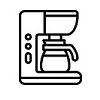 Drip Machine
Drip Machine * 1 tbsp = 5 grams of Coffee Grounds
How to use this Coffee ratio calculator?
I have designed this coffee-to-water ratio calculator with a very simple interface so everyone can use it easily.
Step 1: Choose your brewing method
Select whether you are using a drip machine, pour-over, French press, or other brew methods. This tells the calculator the appropriate ratio range.
Step 2: Select the number of cups you want to brew
Input how many total cups of coffee you want to make, from 1 up to a full pot.
Step 3: Select the intensity of your drink
Choose Light, Medium, or Strong to indicate your preferred coffee strength and adjust the ratio accordingly.
Step 4: Calculate how much coffee you need
Hit calculate and the tool will determine the ideal amount of coffee grounds needed for your settings in both grams and tablespoon. It accounts for all the variables!
Understanding Coffee measurement
Standard coffee cup
While it varies globally, in the United States the standard coffee cup size is generally considered 8 fluid ounces.
However, some coffee gear like the Chemex uses a 5-ounce cup measurement. And countries on the metric system define a cup as 250ml, which is about 8.5oz. And in some countries, the standard coffee serving is 10-12 oz.
So the “standard” cup size ranges from 5-12 ounces depending on where you are.
how much is a scoop of coffee
The most common standard coffee scoop size is 2 tablespoons, which equals around 10 grams or 0.35 ounces of ground coffee.
However, scoop shapes and sizes vary widely from flat-bottom to rounded. So the exact weight can range from 8-12 grams per scoop depending on style.
For consistency, it’s best to calibrate your coffee scoop in grams with a weighing scale.
how many grams of coffee in a tablespoon or Teaspoon
One tablespoon of coffee grounds is approximately 5 grams, while a single teaspoon holds around 1.7 grams of coffee grounds.
For reference, a standard 8 oz cup of coffee needs around 15-20 grams of coffee grounds. So three level tablespoons or around eight leveled teaspoons will provide enough coffee for a full mug.
Why is Coffee to water ratio important?
The coffee-to-water ratio is one of the most important factors in brewing coffee. It affects the strength, flavor, and mouthfeel of your drink. Using the right ratio will ensure that your coffee is balanced and enjoyable.
Using too much coffee can result in a bitter and overpowering drink while using too little can produce a weak and bland brew.
The ideal ratio highlights the natural flavors of the coffee beans and balances the sweetness, acidity, and body.
Coffee to water Ratio Explained
Coffee water ratio for French Press
For 1 cup (8 oz) of perfect French Press coffee, you should use 15 grams (3 tbsp) of coffee grounds.
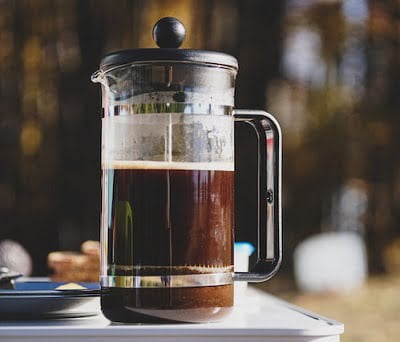
The French press is an immersion brewing method where coarse coffee grounds are steeped in hot water for several minutes. This is my personal favorite brewing method.
According to renowned coffee expert James Hoffman, an ideal coffee-to-water ratio for a French press is 30 grams of coffee to 500 grams of water, which equals a 1:16.6 ratio.
However, I prefer to use a ratio of 1:15, as I find it produces a stronger, bolder flavor that I enjoy.
Use these coffee water ratios for French Press
| Mild | 1:17 |
| Medium | 1:15 |
| Strong | 1:13 |
Coffee water ratio for Espresso
For a single shot of Espresso (1 oz), you should use 7-9 grams (1.5 tbsp) of coffee grounds.
Espresso is a very strong and concentrated coffee that is made with a high coffee-to-water ratio. The ideal ratio is 1:2, meaning that for every 1 gram of finely ground coffee, you should pull 2 grams of water.

Use these coffee water ratios for Espresso
| Mild Lungo Shot | 1:3 |
| Standard Espresso Shot | 1:2 |
| Concentrated Ristretto Shot | 1:1 |
*The size of an Espresso shot is 30 mL so you might think a 1:2 coffee water ratio equates to 15 grams of coffee for a shot of Espresso. But that’s not the case, In reality, pressurized extraction increases the volume of espresso, but the amount in grams remains around 15 to 20, so we use 7-9 grams of ground coffee.
Coffee water ratio for Drip Machine
For a single cup of Drip Coffee (8 oz), you should use 13-15 grams (2.5 tbsp) of coffee.
Drip coffee, the regular black coffee brewed in automatic coffee machines, uses a lower coffee-to-water ratio for a smooth and balanced taste. The ideal ratio for drip is around 1:17, meaning for every 17 grams of water, add 1 gram of medium-grind coffee.
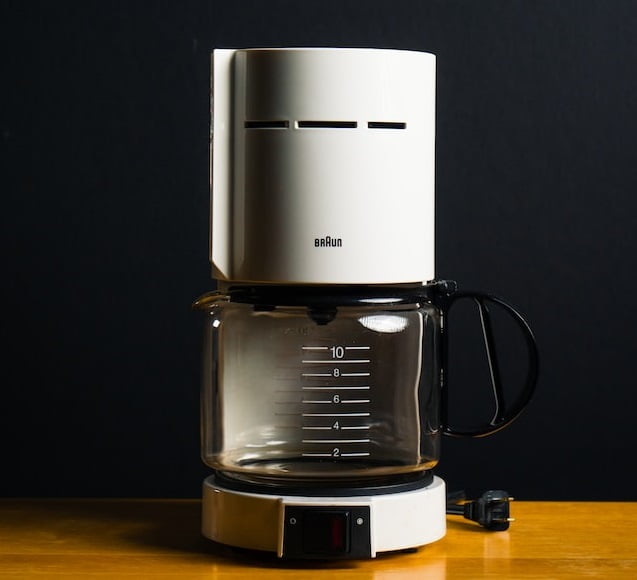
Use these coffee water ratios for the Drip Coffee machine
| Mild | 1:17 |
| Medium | 1:15 |
| Strong | 1:13 |
Coffee water ratio for Aeropress
For making a strong Espresso like coffee with Aeropress use 20 grams (4 tbsp) of coffee for a 4 oz serving.
The AeroPress coffee maker was invented by Alan Adler to produce a coffee reminiscent of espresso.
The creator recommends using an Aeropress ratio of 1:6 – for every 6 grams of water, use 1 gram of finely ground coffee. This produces a concentrated shot that can be diluted with water or milk to taste.
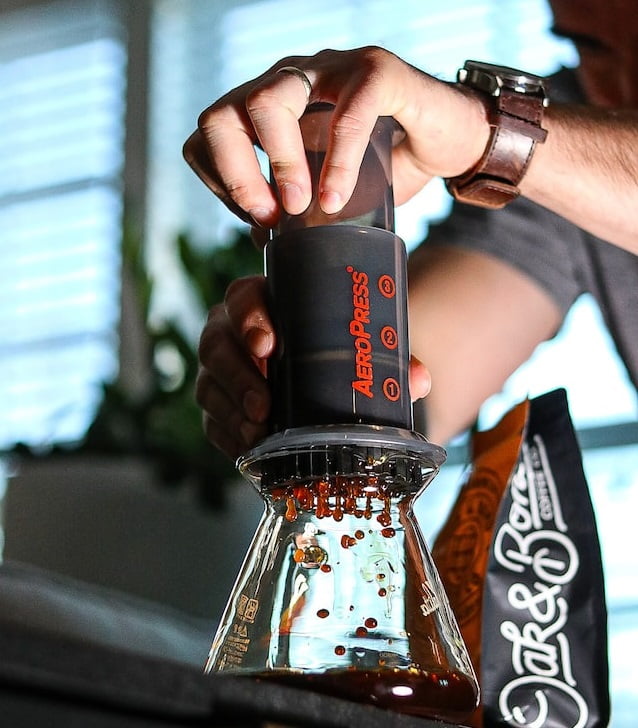
Use these coffee water ratios for Aeropress
| Mild | 1:15 |
| Medium | 1:10 |
| Strong | 1:6 |
Coffee water ratio for Siphon
The ideal coffee-to-water ratio for siphon coffee is around 1:15 to 1:17. This means using 15-17 grams of coffee per 250 ml (8 oz) of water.
A siphon coffee brewer is a unique brewing method that uses heat and vacuum pressure to create a smooth and light-bodied cup of coffee. It consists of two chambers, one on top and one below, connected by a tube.
As the water heats up in the lower chamber, it rises to the upper chamber, where it mixes with coffee grounds. The coffee is then brewed by gravity as the water cools and condenses back into the lower chamber.
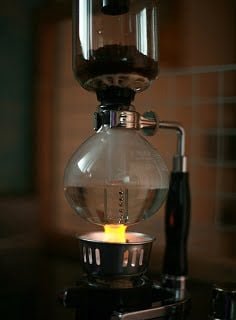
Use these coffee water ratios for Siphon
| Mild | 1:18 |
| Medium | 1:16 |
| Strong | 1:14 |
Coffee water ratio for Cold Brew
Use a 1:5 coffee-to-water ratio for a strong cold brew concentrate. This means that you should use 50 grams of ground coffee for every 250 grams of water.
You can then dilute this strong cold brew concentrate to taste with milk, water, or ice.
For cold brew ready to drink right away, a less concentrated ratio of 1:10 is best. At this ratio, the flavors are nicely balanced and ready to drink without any dilution.

Use these coffee water ratios for Cold Brew
| Mild | 1:10 |
| Medium | 1:8 |
| Strong | 1:5 |
Coffee water ratio for Moka Pot
A ratio of 1:8 coffee to water makes a strong, concentrated brew like espresso in the Moka Pot. This means 7-8 grams of finely ground coffee per 60ml of water. If you prefer a milder coffee, opt for a 1:12 ratio.
A Moka Pot is a stovetop coffee maker that brews strong, concentrated coffee by passing boiling water pressurized by steam through ground coffee. The pressure from steam makes it similar to espresso.
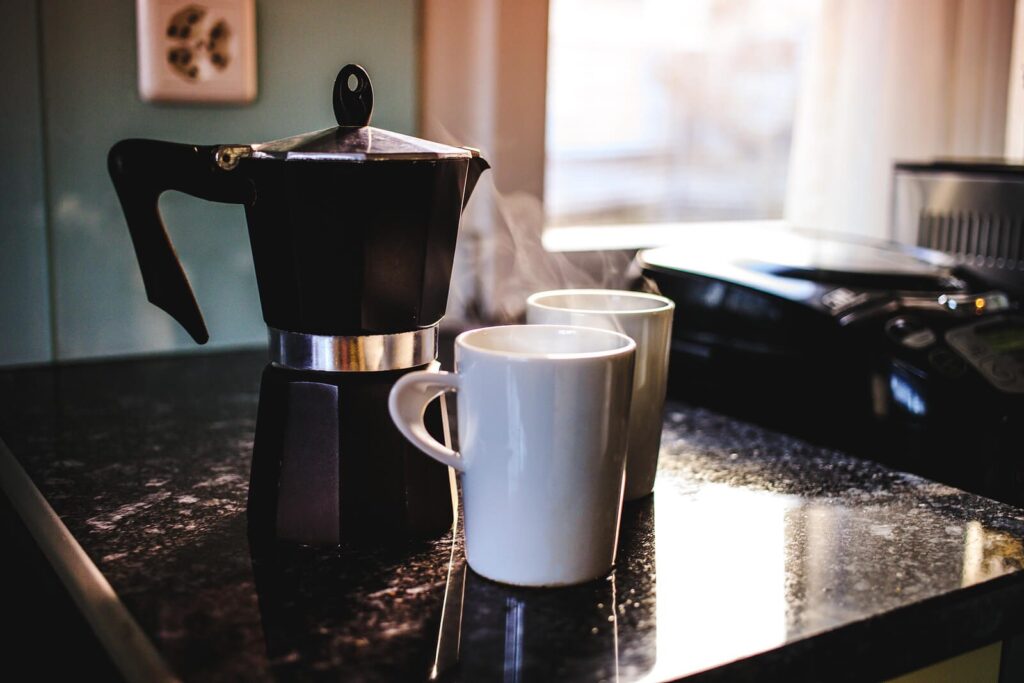
Use these coffee water ratios for Moka pot
| Mild | 1:15 |
| Medium | 1:12 |
| Strong | 1:8 |
Coffee water ratio for Turkish Coffee
For strong Turkish coffee, use a coffee-to-water ratio of 1:9, which is about 7 grams of very finely ground coffee for a 60 ml serving. If you prefer a milder cup, a 1:12 ratio works better.
Turkish coffee is a unique and delicious coffee beverage that is made by boiling finely ground coffee and water together in a cezve. This produces a thick and strong coffee with a rich flavor and a foamy top.
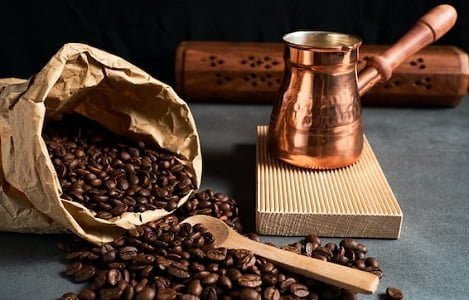
Use these Coffee Water ratios for Turkish Coffee
| Mild | 1:12 |
| Medium | 1:10 |
| Strong | 1:9 |
Coffee water ratio for Pour Over
For pour-over coffee, the ideal coffee water ratio is 1:17, which means 14 grams of medium coffee grounds for every 250 ml of water. If you prefer a stronger brew, you can increase the coffee ratio to 1:14.
The Pour Over method involves pouring hot water in circular motions over ground coffee held in a filter cone. The coffee brews into a receiving vessel below.
As the water steeps through the grounds directly, pour-over is similar to drip coffee but allows more control over water temperature and distribution for optimized flavor.
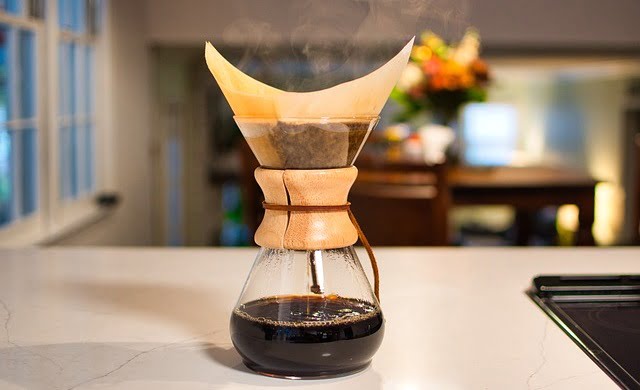
Use these coffee water ratios for Pour Over
| Mild | 1:20 |
| Medium | 1:17 |
| Strong | 1:14 |
Coffee water ratio for Instant Coffee
When making instant coffee, a good coffee powder to water ratio is between 1:30 and 1:50. This equates to about 1-2 heaped teaspoons of instant coffee powder for 250 ml of hot water.
Instant coffee is a quick and convenient form of coffee made from dried coffee extract. It dissolves easily in hot water, making it a popular choice for those seeking a fast caffeine fix without the need for brewing or equipment.
Many people prefer to enjoy instant coffee with milk, which can add creaminess and flavor.
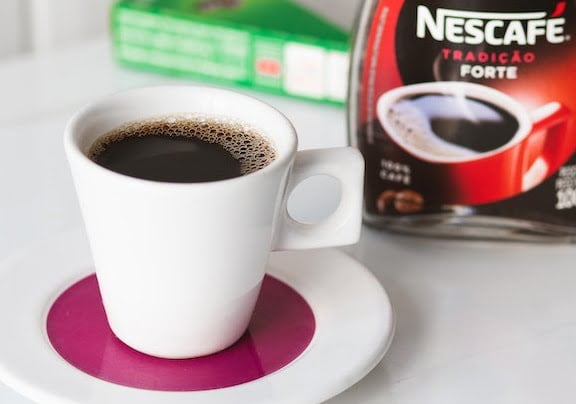
Use these Coffee water ratios for Instant Coffee
| Mild | 1:50 |
| Medium | 1:37 |
| Strong | 1:30 |
What is the golden ratio for coffee?
According to the Speciality Coffee Association
“To achieve the Golden Cup Standard, the recommended coffee-to-water ratio is 55 g/L ± 10%.“
So the Golden ratio for Coffee is around 1:18. This coffee ratio works perfectly for Drip Coffee brewing methods like Hario V60, Chemex, Pour Overs, and automatic drip machines.
It’s a commonly recommended starting point for making a balanced and flavorful cup of coffee. However, you can tweak the ratio based on factors like roast level, grind size, and personal taste.
How does the Coffee Roast type impact the Coffee Water Ratio?
The degree of roasting impacts the flavor profile and ideal brewing ratio for coffee.
Light roasts are denser and harder to extract, so they need a higher water ratio. The light roasting preserves more organic acids and floral, fruity notes.
Conversely, dark roast coffees are less dense and extract more easily. As such, it’s recommended to use less water when brewing dark roast coffee. This prevents over-extraction, which can lead to a bitter taste.
Adjusting the brewing ratios based on roast style allows you to achieve the optimal extraction and flavor for each coffee type.
Tips for brewing a perfect cup of coffee
Here are my 6 pro tips for brewing a perfect cup of coffee every time.
1. Buy fresh whole bean coffee
The key to brewing that perfect cup of coffee is to start with fresh, high-quality whole coffee beans and grind them immediately before brewing.
Whole beans retain their flavor and aroma much longer than pre-ground coffee, which loses freshness and becomes stale quickly.
2. Use the perfect grind size
The proper grind size is paramount, as it dramatically impacts extraction and the balance of flavors. Different brew methods call for different grind sizes.
A finer grind extracts faster, while a coarser grind extracts more slowly. Striking the right balance ensures that you get the full spectrum of flavors from your coffee.
Espresso requires a fine powder-like grind to facilitate quick, intense extraction while a French Press requires a coarse grind since the brewing time is longer.
3. Measure with coffee scale
If you want to make the best cup of coffee, you have to be precise, and a coffee scale is a big help.
The coffee scale is especially helpful during the dialing-in phase, once you know how much a heaped coffee scoop or tablespoon actually weighs, you can continue without the scale.
4. Use Filtered water
The quality of your brewing water is imperative for drawing out the nuanced flavors of your favorite coffee beans. Unfiltered Tap water often contains high mineral content which alters the extraction.
It is always best to use filtered or bottled water when brewing coffee since it retains a perfect balance of minerals, ensuring an optimal extraction of the coffee’s flavor.
5. The water temperature
Water temperature is a crucial factor in brewing a flavorful cup of coffee. The best water temperature for brewing coffee is between 195 and 205 degrees.
Water that is too hot (>205°F) will over-extract the coffee, resulting in a bitter taste. Water that is too cool (<195°F) will leave the coffee under-extracted, resulting in weak and underdeveloped flavors.
6. Keep your coffee maker clean
Make sure to rinse the equipment properly after each use to prevent the buildup of old grounds and oils that can impart stale and bitter flavors.
And give the machines a thorough scrubbing weekly using dish soap and a soft brush to remove any buildup or coffee residue.
For deeper cleaning, it’s recommended to use vinegar or a specialized cleaning solution every 2-3 months.
FAQs
How Can you measure coffee water ratio without scale?
You can use tablespoons for measuring coffee water ratio if you don’t have a measuring scale.
One tablespoon of coffee is roughly equivalent to about 5 grams of coffee grounds.
But remember, it’s not as precise as a scale, so expect a dash of improvisation in your brew.
How much coffee do you need for 50 people?
For 50 people, you’ll need about 700-800 grams of ground coffee, or around 25 ounces. A good guideline is to use about 15-18 grams of coffee per 6-8 oz cup.
I’d round up and go with at least 1 kg or 35 oz of ground coffee so I can have enough to keep that big crowd caffeinated!
What is the most forgiving coffee brewing method?
Drip coffee machine is the most forgiving brew method. Drip pots evenly distribute water and control time and temperature. So even with inconsistent grind size or dosing, it will reliably produce a drinkable cup of coffee.
French Press and Espresso require more precision – a few mistakes and you get weak or burnt results.
